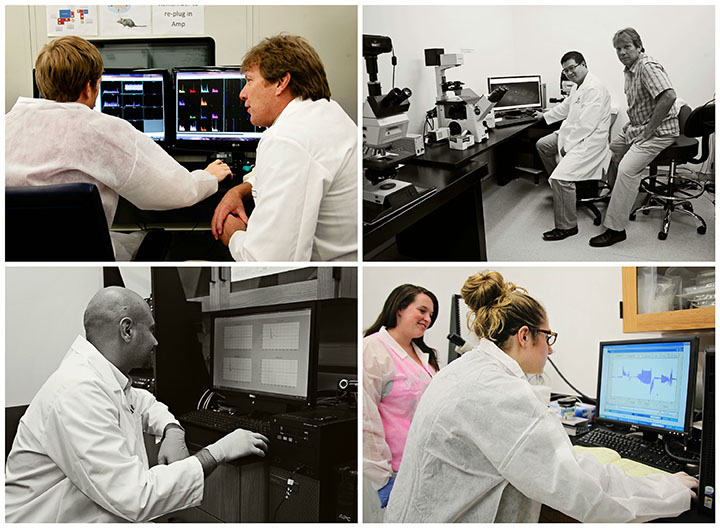Research
Research Facilities - Auditory Neural Engineering Laboratory
Neurophysiology
The Auditory Neural Engineering lab conducts basic and applied research that focuses on neural processing mechanisms in the central auditory nervous system in normal and impaired states. We do so by using single and multi-channel neurophysiology to study the neural coding of complex sounds from large number of neurons. The implementation of multichannel recording and drug-delivery electrodes expedites our studies and allows for comparison to behavioral results acquired from the same subject. Up to recently, the majority of our knowledge of how central auditory neurons encoded various temporal sound features was based on sequential recordings taken over many recording sessions, and using many animals. Multi-channel microtechnology allows us to simultaneously sample extracellular activity from up to 32 channels in awake –tranquilized mice. Recoding and acquisition is based on the Tucker –Davis Technology (TDT) platform, which offer a number of versatile, user-programmable DSP-based systems for real-time stimulus generation in the ultrasonic range and data acquisition featuring real-time spike sorting. Recordings take place in a 10ft double-walled Tracoustics sound booth. The software is accessed via a MatLab GUI user interface, and allows for acquisition of excitatory and inhibitory receptive fields, rate-intensity functions using simple and complex stimuli, gap in noise paradigm, sinusoidal amplitude modulation, and spectro-temporal receptive fields. An aseptic surgery area comprising 250 sq ft is located within the lab and includes a custom stereotaxic apparatus, and operating microscope.
Evoked Potential and Near-Field Electrophysiology
Early and late auditory, and visual evoked potentials, and otoacoustic emissions are performed in a Tracoustics single wall sound booth using TDT hardware and BioSig EP collection software (TDT, Inc.). Both free-field and closed field ABRs and DPOAE data are analyzed using Matlab custom software. In a third sound booth we are able to expose animals to various types of enriched acoustic environments or to noise.
Animal Behavior
In a separate room four startle response chambers, consisting of a plexiglas platform
placed under a speaker mounted to the ceiling allows for acquisition of the acoustic
startle response (ASR). We use pre-pulse inhibition to modulate the ASR through TDT
System III hardware and MatLab software. The behavioral component brings a powerful
tool that allows for comparison of neurophysiology results to behavioral results obtained
in the same subject.
For more information, contact:
